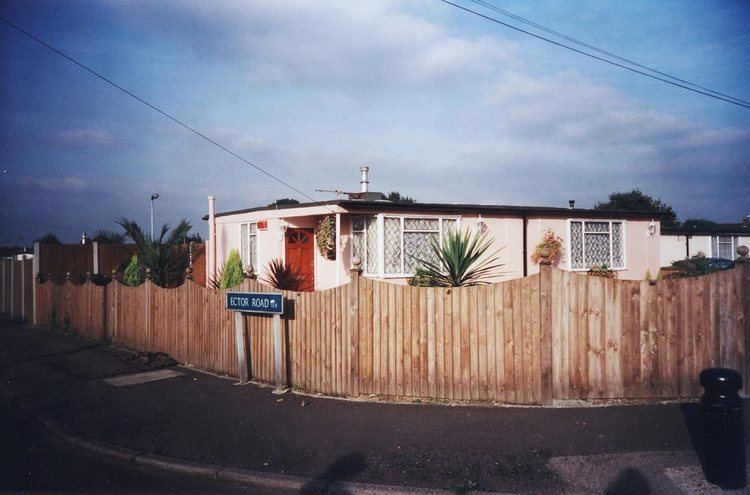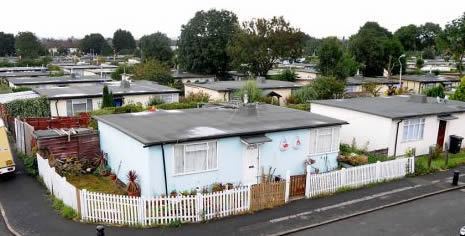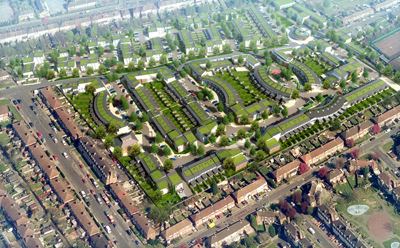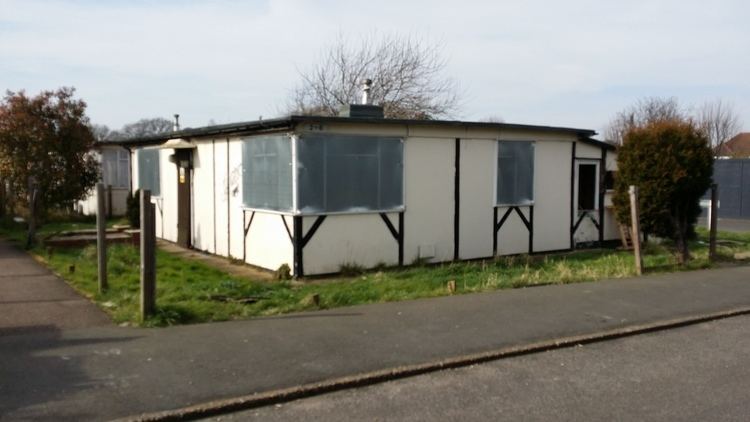OS grid reference TQ385735 Sovereign state United Kingdom Dialling code 020 Post town London | Country England Postcode district SE6 Ceremonial county Greater London UK parliament constituency Lewisham East | |
 | ||
The sad end of the excalibur estate
The Excalibur Estate is a post-war 1940s prefabricated housing estate in Catford, South London. The estate contains the last sizeable collection of post-war prefabricated houses in the United Kingdom. Despite its historical significance, demolition has been proposed for sometime and is scheduled to begin in 2013. English Heritage has granted listed building status to six of the estate's prefabs. The proposed demolition has led to campaigns from residents, English Heritage and the Twentieth Century Society to save the properties, and a legal challenge to prevent redevelopment if they are demolished and return it to parkland.
Contents
- The sad end of the excalibur estate
- Excalibur estate guided tour
- Background
- Etymology
- The estate
- Demolition proposals
- Conservation battle
- Case for demolition
- Redevelopment proposals
- Parkland covenant
- References

Excalibur estate guided tour
Background

Following the London Blitz of the Second World War, London was facing a severe housing shortage. To quickly alleviate this problem, London, like many other British cities set about building temporary prefabricated houses using labour from German and Italian prisoners of war from the Afrika Korps captured during Rommel's North African Campaign.

Fifteen hundred homes in Lewisham were destroyed in the first year of the war alone. The level of destruction across many British cities brought about the passing of the Housing (Temporary Accommodation) Act 1944, which led to the building of Excalibur and many estates like it.

The Excalibur Estate was constructed as one of these projects on parkland in Catford between 1945 and 46 by German and Italian prisoners of war. The estate consists of single-story prefabricated bungalows designed by the Ministry of Works; each with two bedrooms, a private garden and an indoor lavatory.

Despite only being intended to stand for ten years, many prefabricated estates survived much longer. Many corporations replaced such estates with conventional-build or permanent prefabricated council houses throughout the 1950s, 60s and early 1970s. Unusually Excalibur survived and is still standing in 2013.
Etymology
The estate is so called because the streets are named after characters from Arthurian legend. The precise reason for these street names are unknown.
The estate
The estate consists of 187 single storey, two-bedroomed prefabricated bungalows. There are no amenities situated on the estate except for the church, St. Marks. This building is also of a prefabricated construction but, unlike the flat-roofed houses, has a sheet-metal barrelled roof. Catford has a variety of shops and railway stations, the nearest railway station to the estate being Bellingham.
Demolition proposals
As of 2013, the London Borough of Lewisham proposes to demolish all of the properties on the 12 acres (4.9 ha) site. As they are the last large inhabited collection of prefabricated houses of this era, this decision has proved controversial. English Heritage have stepped in and listed six prefabs, exempting them from demolition. Residents were offered a vote between the estate's demolition or transfer of the estate to a private housing association, which would also demolish the properties. Since Lewisham council began relocating residents in preparation for demolition, residents have complained of an increase in crime, flytipping and antisocial behaviour.
Conservation battle
Conservationists have fought to save the estate from demolition, which they claim is a unique surviving example of twentieth-century architecture. Thus far they have succeeded in seeing Grade II listing applied by English Heritage to six buildings on the estate including St. Mark's Church. The conservation of the estate has been spearheaded by the Twentieth Century Society; claiming that the overall layout and planning of the estate is key to its uniqueness and that just keeping six buildings and surrounding them with new houses does not suffice. Despite the Twentieth Century Society campaigning for the entire estate to be made a conservation area and English Heritage recommending 21 buildings be listed, the Department for Culture would only go so far as to list six of the buildings. Under listing guidelines for twentieth-century buildings, only buildings with few moderations should be listed; in the case of Excalibur, most buildings have modified windows and doors. A prominent local resident favouring conservation stated: "The Excalibur Prefab Estate is the largest of its kind now left in Europe. Europe values its war time history, we on the estate think it’s time we did too." Emily Gee of English Heritage said of the estate: "The historical resonance of the estate is considerable. The design of the buildings, with their subtle modern influences, and the community-focused planning of the estate testifies to the thoughtfulness of post-Blitz reconstruction."
Case for demolition
Lewisham Council have rebutted claims that the houses have historical significance and have maintained that it would be "virtually impossible to bring them up to modern standards, a view shared by a number of residents, who are mainly council tenants." The council have repeatedly argued that residents favour redevelopment; citing a recent poll amongst residents in which 56 percent voted in favour of redevelopment. Conservationists have argued this result was inevitable as residents felt there was very little prospect of the council spending any money on their homes, leaving them in outdated accommodation. Of the estate Lewisham Council stated "We have a responsibility under the national Decent Homes programme to bring all its housing up to a recognised standard. It simply is not financially viable to refurbish the estate." Of the listing, Steve Bullock said. "The listing by English Heritage was perverse and it has made me extremely concerned about the way that organisation behaves… These are temporary prefabricated buildings, not architectural gems"
Redevelopment proposals
In April 2011, Lewisham Council approved a plan to replace the prefabs with 371 homes. The project is set for completion by 2018. The project is proposed by Lewisham Council and L&Q who jointly claim that the Excalibur Estate falls short of the standards required by the Decent Homes Standard.
Parkland covenant
Campaigners argue that the proposal to build new homes on the site may be subject to legal challenge. Prior to the building of the prefabs, the land was parkland. The land was donated by the then Governor-General of Australia, Lord Forster to the then London County Council as parkland. In a 1946 letter, the London County Council promised to return it to parkland once the temporary houses had been cleared.
Parts of the original Forster Memorial Park are still in existence to the west of Excalibur. Other housing however separates Excalibur from the remaining parts of the park, so if returning the estate to parkland were to become a reality, Forster Memorial Park would be divided into two parts by Longhill Road and Battersby Road.
